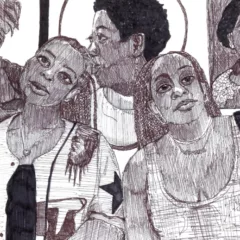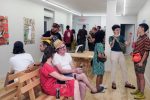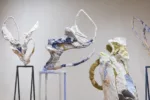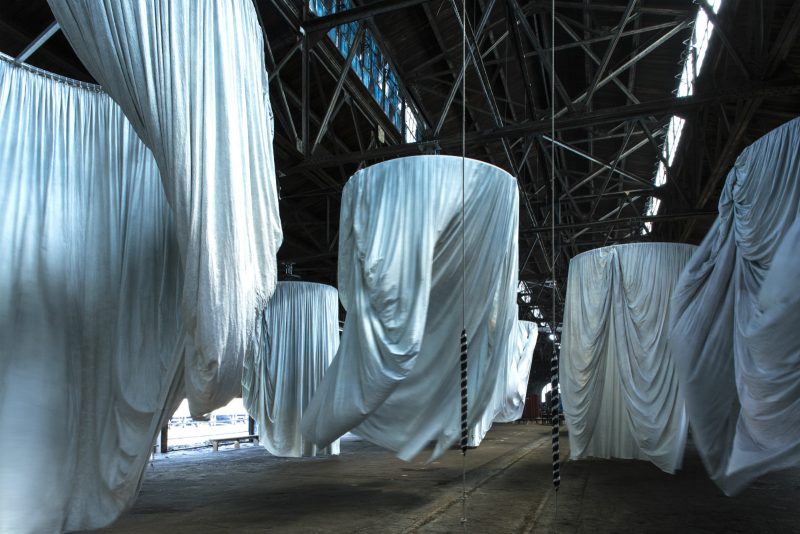
Ann Hamilton is the rare artist who can harness the power of very large spaces and she’s done so again at both the riverfront warehouse at Municipal Pier 9–on view through October 10, 2016–and at the Fabric Workshop Museum through January 8, 2017. The Fabric Workshop has organized both portions under the joint title, “habitus,” and both installations were designed by the artist, with supremely poetic feelings for the spaces.
Whirligigs of fabric
The installation at Pier 9, open to ambient weather conditions at the front and side of an enormous warehouse, consists of a dozen huge pendant circles of fabric curtains, each tucked up in swags at points, which spin to the action of bell-rope pulleys. The curtains’ endless movement in a counterclockwise direction is like the coordinated circling in a ballroom of dancers doing a Viennese waltz. Hamilton always invokes more than one sense with her work; here it is the sight of the swirling fabric, the oddly musical sound of the pulley mechanisms, and the touch of the pulleys–which visitors are encouraged to operate–as well as the physical sense of wind on the body from both the swirling fabric and the river breezes.
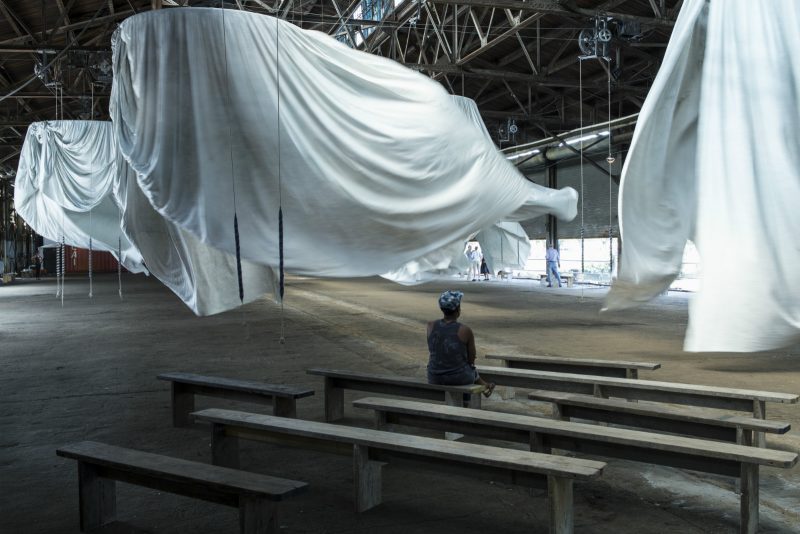
“Habitus” has the rare ability to turn an involved visitor into a child again–able to succumb purely to sensations. I stood inside one of the circular curtains as it spun, and looking up I experienced the exhilaration of being on a rollercoaster, without the queasiness in my stomach. As the curtain spun to the action of the pulley–operated by FWM staff when other visitors weren’t–it brushed along my body in varying patterns that shifted with the wind, which at one point was strong enough that I found myself outside the Tyvek curtains, although I’d started within. Adults aren’t usually offered such fun. It’s an experience available for a limited period of time, and not to be missed by children of all ages.
“Habitus,” a term most often used in sociology, refers to the inclinations of a group of people of a common background towards ways of thinking and behaving in social situations. Hamilton has structured both parts of the exhibition around her ongoing preoccupation with both fabric–that man-made material which we all wear next to our skin–and reading, texts, and textiles. She is interested in the making and unmaking of both. While the artist may have a precise connection of the various parts of “habitus” at both venues, I’d suggest that visitors succumb to the sensual allure and let the ideas arise as an induced series of associations, which is the way many artists deal with written materials. This is not work with a singular concept which requires a precise explication of its individual parts to make sense.
Behind the whirling fabric in the warehouse two figures perform repetitions, one spinning wool with a hand spindle, the other rending a sweater with a knife. Like Penelope, weaving and unweaving the shroud of Odysseus while he is off fighting the Trojan War, these figures are making and unmaking. As they work, two poems by Susan Stewart are projected in an endless loop onto a shipping crate. Stewart’s poetry has been important to Hamilton, and they have collaborated before (and they will do a reading together at Pier 9 on October 8 from 6–7:30 pm). On the first floor of the Fabric Workshop Museum is another work utilizing the same two poems, this time inscribed on a piece of cloth which reveals the text as it is wound from one reel to a second one, then back again. Hamilton asked the poet to use the format of palindrome poems, which make sense in both directions.
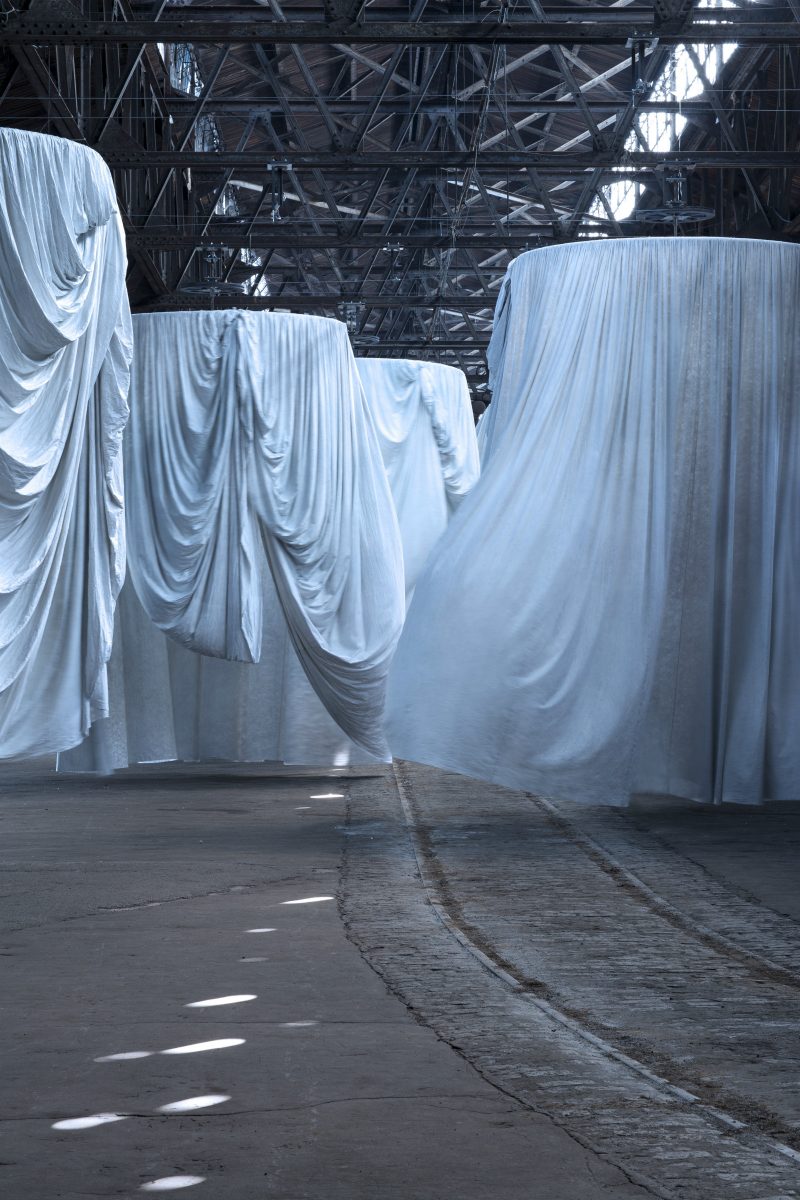
From municipal pier to museum wall
The rest of the ground floor of the Fabric Workshop Museum includes a range of Hamilton’s work, selected and installed to create a monochrome environment the color of eggnog. It includes one single-channel video and an installation of two looped videos, several poems embroidered on various textiles and a porcupine-like man’s suit made of toothpicks. She has installed work on two upper floors including several of her own objects interspersed among a selection of objects borrowed widely from area collections and falling into two categories: textile-related material, including fabric swatches, dye examples, weaving and sewing patterns, dolls dressed in hand-sewn outfits, woven blankets, and sewing tools; and commonplace books, which are a form of diary, made up of selections from favored texts, that were popular before Xerox rendered hand-transcription obsolete. Both floors also offer visitors a chance to make their own commonplace books. Hamilton set up a website soliciting passages of text which make reference to textiles, then printed several hundred examples, each formatted according to her design. A long wall shelf on each floor holds stacks from which visitors can make a selection.
Both upper floors testify to Hamilton’s sculptural sensibilities; they are hands down the most beautiful installations I have ever seen in the deep and somewhat awkward spaces at 1214 Arch Street. The eighth floor is filled with work in flat display cases designed by the artist so their legs extend upwards where they are connected by railings, looking like canopy beds stripped of their curtains. Each has a sheet with identifying labels tied to the case, although visitors may simply wish to enjoy the assembly, which was arranged according to the artist’s visual sensibilities rather than a curator’s systematic and didactic display. But those who read the labels will discover some gems, including commonplace books by Philadelphia sculptor William Rush–memorably painted by Thomas Eakins as he worked from a nude model–Samuel Butler, and Charles Lamb, a small book which Hamilton has unmade by scratching out each line of text, and a fifth-grade schoolbook for sewing class with examples of darning, stitching, and pattern-making.
The sixth floor is distinguished by a sensitive openness of display, marked by several composites of Xerox reproductions of items of dolls’ clothing which have been digitally enlarged to poster size and printed on gampi paper, then mounted to fabric. The process resulted in work with soft, slightly-indistinct details, a wax-like sheen and unevenly textured surfaces that are unlike anything I’ve ever seen. They are monumental and intimate at the same time, and thoroughly seductive. Hamilton has also made sculptural use of a long, cantilevered shelf opposite the entrance, supporting boxes of textile fragments, arranged for their use in classes taught at Philadelphia College of Textiles and Science, now Philadelphia University, which lent them. The facing wall has a similar shelf of results from Hamilton’s crowd-sourced texts to be assembled into commonplace books by visitors. Look long, and touch.
Ann Hamilton’s “habitus” at Municipal Pier 9 is on view through October 10, 2016, and at the Fabric Workshop Museum through January 8, 2017. Open Tuesday–Sunday, 12–6 pm. Ann Hamilton will be giving a lecture on October 6 at 5:30 pm, and Susan Stewart and Ann Hamilton will also be doing a poetry reading together on October 8 at 6 pm.



